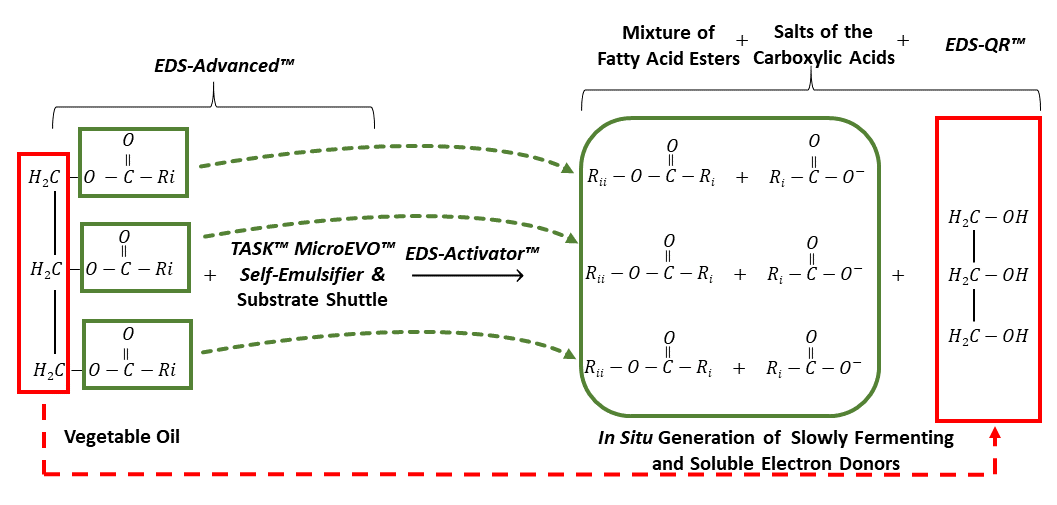EDS-Advanced™ In Situ Alcoholysis
EDS-Advanced™
Anaerobic Bioremediation Deploying Electron Donor Via In Situ Alcoholysis
Emulsified vegetable oil (EVO) slowly ferments and can act in the subsurface as an organic carbon and hydrogen source that stimulates organohalide-respiring bacteria that in turn mineralize chlorinated solvents. Indigenous microorganisms first consume and ferment EVO to generate hydrogen, fatty acids and other important nutrients and cofactors. The prevailing anaerobic conditions are ideal to reduce chlorinated solvents like PCE and TCE through dechlorination processes such as dehaloelimination. Then specialized bacteria such as Dehaloccocoides mcCartii, Dehalobacter or Dehalogenomonas use subsurface-generated hydrogen when transforming reduced solvent compounds like 1,2-DCA, 1,1,2-TCA, cis and trans-DCE to Vinyl Chloride and innocuous Ethene.
Although emulsifying vegetable oil allowed overcoming limitations of pure vegetable oil injection and minimize field interventions by using a long-lasting electron donor, hundreds of EVO injection events over the past years has demonstrated that EVO effects are limited to the area in the immediate vicinity of the injection point. This is evident through low TOC values measured even tens of meters downgradient to injection points where only acetic acid predominates. A favorable fatty acid diversity seems to be limited to the injection points immediate vicinity (< 5 meters). Another inconvenience that becomes more evident when using permanent, screened wells is biofouling. This phenomenon is typically attributed to biomass developing in the aerobic vicinity of injection wells due to hydrophobic oils creating a film (residual electron donor) that stimulates biomass growth. In many cases, biofouling or permeability losses could very well be attributed to geochemical incompatibilities between EVO and cations in the subsurface, or EVO’s intrinsically high retention to soils.
Surfactant specialists at Tersus designed EDS-Advanced™ to overcome two of the main challenges associated with EVO injection: poor fatty acid subsurface distribution and biofouling. EDS-Advanced™ is a water-miscible, slowly-fermenting and aquifer buffering electron donor.
Shipped as a two-part system, EDS-Advanced™ comprises:
- A water-miscible vegetable oil blended with a substrate shuttle. A substrate shuttle is a water-miscible solvent that dissolves the vegetable oil creating a solution with the distribution properties of a soluble electron donor.
- A catalyst (branded as EDS-Activator™) to promote the formation of fatty acid alkyl esters, carboxylic acid salts and EDS-QR™.
The addition of the substrate shuttle creates a solution that is more readily dispersible than EVO in aquifers and the subsurface by advection. An easy-to-distribute substrate such as EDS-Advanced™ means that an injection point can create greater radii of influence (ROI) which in turns reduces the required number of injection points to adequately supply a contaminated aquifer with electron donor. In other words, a larger volume of substrate can be dispersed from a single injection point.
The EDS-Activator™ reacts in situ with the water-miscible vegetable oil cleaving the fatty acids of the oil’s triglyceride molecule. The fatty acids attach to the alkyl group of an alcohol and form fatty acid alkyl esters, carboxylic acids salts and EDS-QR™, as shown in the figure below. The products formed in situ travel far easier than EVO, add a pH buffer to the system and leave the system less susceptible to clogging and biofouling.
In Situ Alcoholysis of EDS-Advanced™

Advantages
- Improved subsurface distribution of a vegetable oil-based electron donor
- Improved ROI, fatty acid distribution and TOC when compared to EVO
- Eliminates dependence on EVO droplet size
- Aids in reducing cVOC inhibitory concentrations by sequestering DNAPL
- Less susceptible to clogging and biofouling